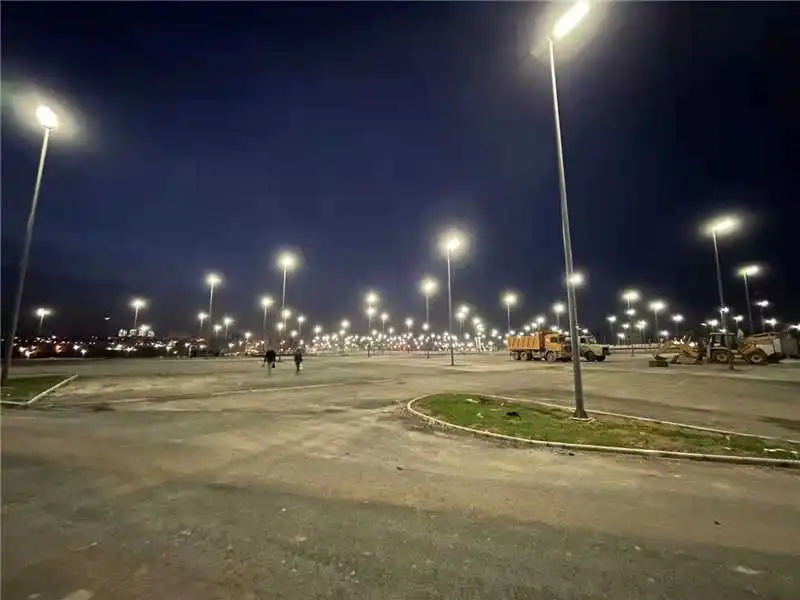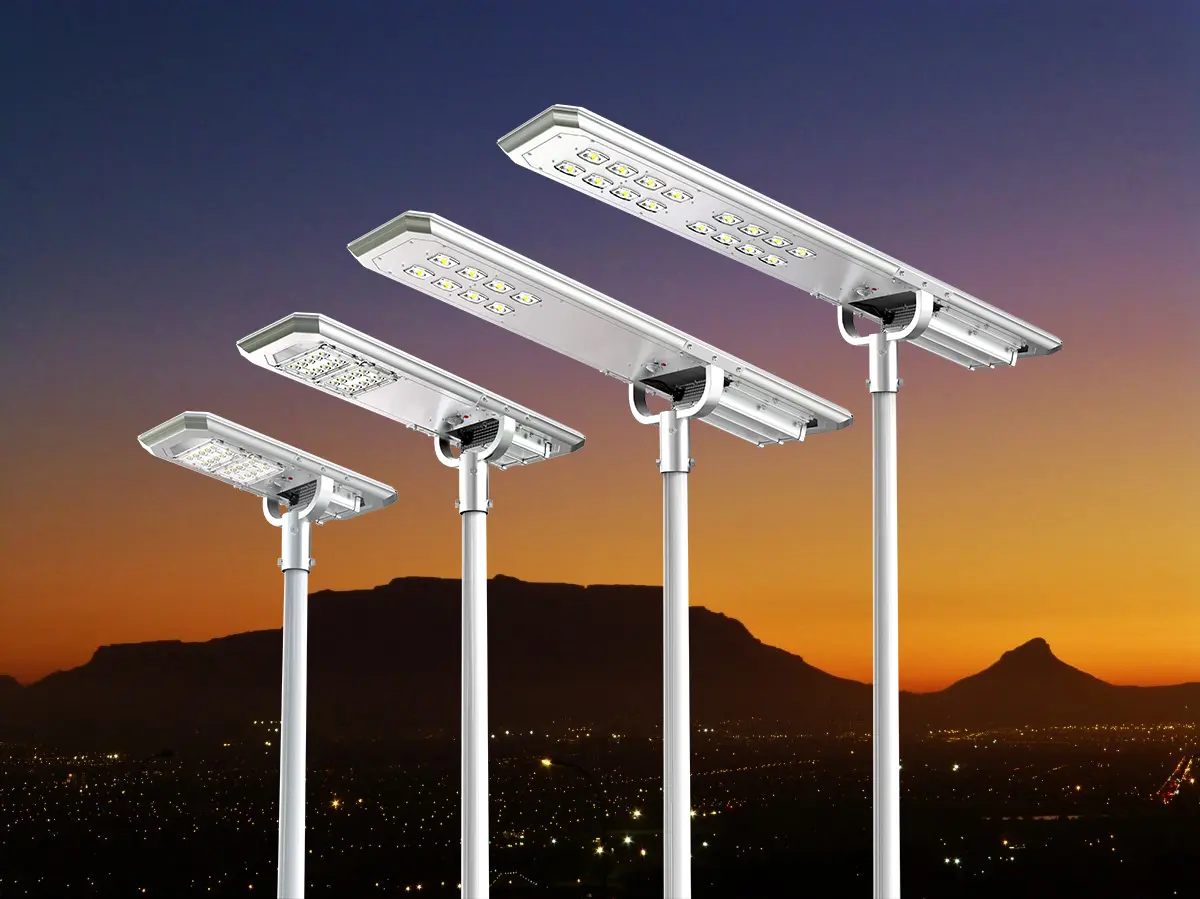1. Project Background and Requirements Analysis
1.1 Project Overview: A New Landmark for the City of Oran
The Oran Stadium, located in Algeria’s second-largest city, Oran, is a national-level large-scale sports venue with an extensive surrounding complex, including parking lots and connecting roads. As part of a major infrastructure upgrade, this project aimed to deliver a comprehensive nighttime lighting solution for both the stadium and its surrounding areas.
A total of 5,000 Sresky ATLAS series solar street lights were deployed across the site, enhancing both functionality and the modern urban image of Oran. Beyond being an upgrade of sports facilities, the project represents a landmark step in Algeria’s efforts to promote urban development and sustainable growth. With the adoption of advanced solar lighting technologies, Oran Stadium has become a shining example among African sports venues.
1.2 Core Challenges and Lighting Requirements
Energy Independence and Cost Control
The vast public space consumes large amounts of electricity, and long-term reliance on the municipal grid would lead to high operational costs. A lighting system independent of the grid was required to significantly reduce energy expenses.
All-Weather Reliability
With high foot traffic, especially during nighttime events, the lighting system needed to offer 100% reliability to ensure public safety. North Africa’s intermittent rainy seasons also demanded high solar charging efficiency.
Extreme Climate Adaptability
Algeria’s hot summers, strong sunlight, and frequent sandstorms required lighting equipment that could withstand high temperatures and dust erosion for long-term stable performance.
Safety and Security Standards
Wide parking lots and access roads required bright, uniform lighting to eliminate dark zones, prevent crime, and ensure safe passage for pedestrians and large vehicles.
Alignment with Sustainable Development Goals
As a flagship national project, the stadium’s lighting system needed to reflect Algeria’s commitment to sustainability by adopting clean, renewable energy technologies.
2. Technical Solution Design
2.1 Product Selection: Why Choose the Sresky ATLAS Series Solar Street Lights?
Given the project’s demanding specifications, the Sresky ATLAS series stood out due to its superior performance and excellent adaptability. These solar street lights fulfill the requirements for energy independence, reliability, and environmental resilience—making them the optimal choice for the Oran Stadium project.
2.2 Key Technical Advantages and Compatibility Analysis
Core Technology 1: TCS Intelligent Temperature Control System
-
Function: Prevents lithium battery degradation and performance loss caused by high temperatures.
-
Adaptability: In Algeria, where summer temperatures often exceed 40°C, TCS maintains optimal battery performance by ensuring a charging range of 0–45°C and a discharging range of -20–60°C.
Core Technology 2: ALS Intelligent Light Decay Compensation
-
Function: Adjusts lighting output during extended periods of cloudy or rainy weather to ensure consistent illumination.
-
Adaptability: Provides reliable lighting even after more than 10 consecutive days of poor sunlight, meeting safety requirements for large venues.
Core Technology 3: PIR Smart Human Sensing
-
Function: The 120° PIR sensor with an 8-meter detection range activates lighting when motion is detected, enhancing safety and saving energy.
-
Adaptability: Ideal for parking areas and low-traffic zones, this feature ensures smart energy use and improves nighttime security.
Exceptional Lighting Performance and Durability
-
High-Efficiency LEDs: Equipped with OSRAM chips, offering luminous efficiency up to 230 lm/W—delivering bright light while minimizing power use.
-
Rugged Design: With IP65 waterproof and dustproof rating, IK08 impact resistance, and a durable aluminum alloy body, the ATLAS series withstands extreme weather and physical wear.
These features make the Sresky ATLAS series the ideal solution, meeting both technical and environmental demands.
3. Project Implementation and Rollout
3.1 Planning and Deployment
Phased Installation Approach
Given the project scale of 5,000 units, a phased and zone-based deployment strategy was adopted—starting with major roadways and expanding to parking areas. This ensured efficient installation and maintained construction quality.
3.2 Installation Process
Standardized Construction Procedures
Following Sresky‘s installation guidelines, the construction team carried out standardized steps including foundation cage installation, pole mounting, and luminaire assembly—ensuring quality and safety at every stage.
Maintenance-Friendly Modular Design
The ATLAS series features a modular system where all components can be easily replaced on-site, streamlining future maintenance and enabling effective large-scale management.
4. Project Outcomes and Impact
4.1 Social Value
Improved Public Safety
The 5,000 solar lights offer bright and uniform illumination, significantly improving nighttime visibility, reducing traffic accidents and crime, and enhancing safety for locals, tourists, and athletes.
Enhanced Urban Image
The modern appearance of the ATLAS solar lighting array has become a distinctive urban feature, boosting the city’s infrastructure appeal and international visibility.
Boost to the Nighttime Economy
Reliable lighting enables nighttime events and commercial activities at the stadium, stimulating local economic development.
4.2 Economic and Environmental Benefits
“Zero Electricity Bill” Operation
Powered entirely by solar energy, the 5,000 units incur no grid electricity costs—resulting in substantial long-term economic savings for the operator.
Environmental Contribution
The project significantly reduces annual carbon emissions, reinforcing Algeria’s commitment to renewable energy adoption and sustainable urban planning.
Conclusion
The Oran Stadium lighting project exemplifies how advanced technologies—such as TCS and ALS—can be successfully integrated with practical, large-scale needs. Through the deployment of 5,000 Sresky ATLAS solar street lights, the project not only resolved critical lighting challenges but also delivered lasting social, environmental, and economic benefits.
This landmark project has set a benchmark in African solar infrastructure and provides a valuable blueprint for similar international developments. With innovation, reliability, and sustainability at its core, Sresky continues to earn the trust of global partners and lead the way in the solar lighting industry.
Table of Contents

